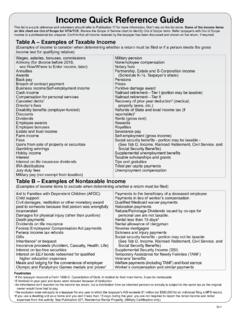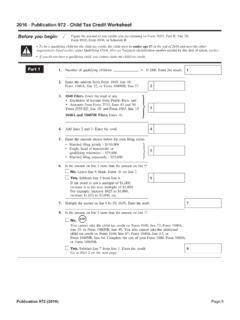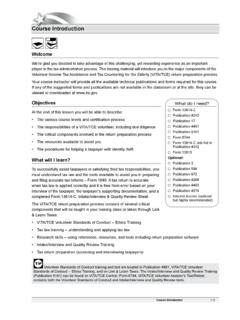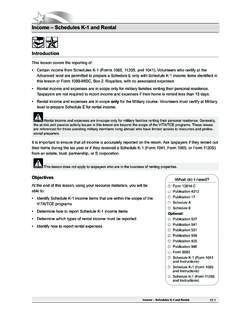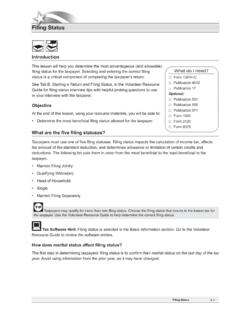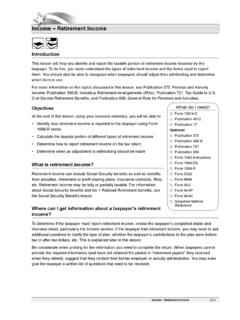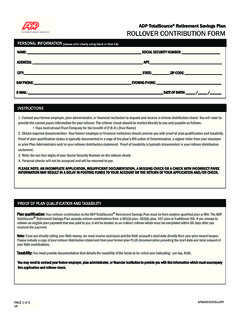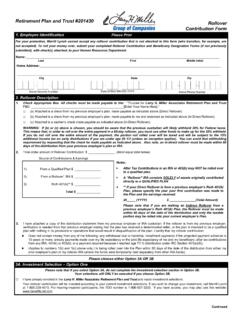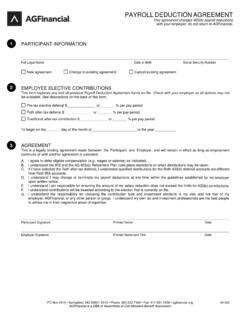Transcription of Introduction Objectives Topics - Internal Revenue Service
1 Page 1 Income retirement Income Time Required: 15 minutes Introduction Objectives Topics This lesson will help tax preparers identify and report the taxable portion of the taxpayer s retirement income. Identify how retirement income is reported to the taxpayer using form 1099-R series. Calculate the taxable portion of different types of retirement income. Determine how to report retirement income on the tax return. Determine when an adjustment to withholding should be made. retirement Income Documents retirement plan Distributions Taxable IRA Distributions Reporting IRA Distributions Taxable Pensions and Annuities Other retirement Income Issues When to Adjust Withholding Key Terms Annuity: A series of payments under a contract from an insurance company, a trust company, or an individual.
2 Annuity payments are made at regular intervals over a period of more than one full year. After-tax Contributions: After-tax means the employee paid taxes on the money when it was contributed, , the taxpayer has a cost basis in the plan . Before-tax Contributions: Before-tax simply means that the employee did not pay taxes on the money at the time it was contributed, , the taxpayer has no cost basis in the plan . Excludable Income: Income that is not included in the taxpayer's gross income and therefore exempt from federal income tax. Certain income may be exempt from tax but must be reported on the tax return.
3 form W-4P: Withholding Certificate for Pension or Annuity Payments. The form allows taxpayers to tell payers the correct amount of federal income tax to withhold from payments. form W-4V: Voluntary Withholding Request, filed by taxpayers (or estates) who are recipients of social security benefits and want to request withholding from their payments from the Social Security Administration. Individual retirement Arrangement (IRA): A tax-sheltered retirement savings plan set up by the taxpayer. Lump-Sum Distribution: A lump-sum distribution is the distribution or payment within one tax year of an employee s entire balance from all qualified pension, stock bonus, or profit-sharing plans that the employer maintains.
4 Railroad retirement Benefits (RRBs): Benefits paid to railroad retirees covered by the Railroad retirement Act. The RRA has two components. Tier 1 is the equivalent of social security benefits and Tier 2 is like an employer's pension plan . Required Minimum Distribution (RMD): The amount that must be distributed each year from a retirement plan or IRA. Income retirement Income page 2 retirement Income: retirement income can include social security benefits as well as any benefits from annuities, retirement or profit sharing plans, insurance contracts, IRAs, etc.
5 retirement income may be fully or partially taxable. Rollover: Generally, a rollover is a tax-free distribution to the taxpayer from one retirement account (traditional IRA or employer's pension plan ) that rolls over into another qualified retirement account within 60 days. Simplified Method: This method is used to calculate the tax-free portion of each pension or annuity payment. Teacher Tips Guidelines for Lesson Guideline Instructor Notes Presentation Aids Lesson background info Review the online demo of TaxSlayer on Income. TaxSlayer Demo: From the Practice Lab, select: TaxSlayer IRS training Click the appropriate demo Provide details and engage the students Discuss all tips and cautions in detail.
6 Ask students to read and/or role-play examples and sample interviews. Review answers to each exercise; ask students how they arrived at their answers. Internet: Link & Learn Taxes (L<) Income retirement Income; form 1040 Income retirement Income page 3 Topic-specific Tips Topic Name Instructor Notes Presentation Aids Introduction Review lesson Objectives . Point out that this lesson is one of the nine lessons on income. Review list of references. State the presentation time. Remind students this lesson does not cover social security benefits or tier 1 railroad retirement benefits (this is covered in another lesson).
7 Remind students when reviewing form 13614-C with taxpayers to clarify the type of retirement plan ( , whether the income was before-tax or after-tax dollars). Discuss key terms used in this lesson. Direct students to Pub 4012, Table A Examples of Taxable Income and point out types of retirement income. Visuals: form 1040, Page 1 Income section form 13614-C, Page 2, Part III Forms 1099-R, 5329, 8606 Pub 4012, Income tab, Table A Examples of Taxable Income Pub 17, Chapters 10 and 17 Internet: YouTube video: How IRAs Help to Increase Your retirement Savings YouTube video: IRA Investment Decisions What You Need to Know retirement Income Documents Use the Landing Page questions to prompt students to share what they know about retirement income.
8 Review L< topic retirement Income Documents. Ask students to identify forms used to report retirement income. Ask students what they know about the form 1099-R series. Emphasize that Basic certified volunteers can complete the return only if the taxable amount is indicated on form 1099-R. The Advanced level covers computing the taxable amount. Direct students to Pub 4012, IRA/Pension Distributions. Visuals: Student Landing Page questions form 1099-R, box 7 and 2a form 5329 form 1040 Pub 4012, Income tab, form 1099-R Internet: L< retirement Income, retirement Income Documents Income retirement Income page 4 Remind students that any amount from box 4 of Forms 1099-R, CSA- and CSF-1099-R is entered in the Payments section of the return.
9 retirement plan Distributions Review L< topic retirement plan Distributions. Remind students that, if the payer did not include the taxable amount in box 2a of Forms 1099-R, CSA- or CSF-1099-R, or if the taxpayer has form RRB 1099-R, they will have to compute the taxable portion of the distribution. Emphasize the difference between before-tax and after-tax contributions, and how the difference determines if the distribution is taxable. Review the table regarding taxable and nontaxable contributions and distributions in this topic. Direct students to Pub 4012, IRA/Pension Distributions.
10 Visuals: form 1099-R Pub 4012, Income tab, form 1099-R Internet: L< retirement Income, retirement plan Distributions Taxable IRA Distributions Review L< topic Taxable IRA Distributions. Ask: What is the difference between distributions from Roth IRA and a traditional IRA? Answer: Generally, Roth IRA distributions are tax-free if requirements are met. Traditional IRA distributions may be fully or partially taxable. Emphasize: Distributions from SIMPLE and SEP IRAs are in scope for VITA/TCE, because they are taxable and are generally reported on the return just like taxable traditional IRA distributions.
